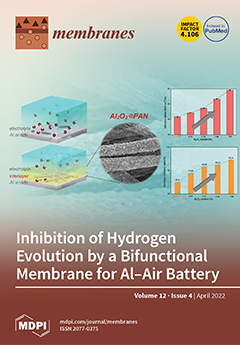A three-step surface modification consisting of activation with NaOH, functionalisation with a silica precursor and organofluorosilane mixture (FSi
T), and curing was applied to a poly(vinylidene fluoride) (PVDF) membrane for the recovery of dissolved methane (D-CH
4) from aqueous streams. Based
[...] Read more.
A three-step surface modification consisting of activation with NaOH, functionalisation with a silica precursor and organofluorosilane mixture (FSi
T), and curing was applied to a poly(vinylidene fluoride) (PVDF) membrane for the recovery of dissolved methane (D-CH
4) from aqueous streams. Based on the results of a statistical experimental design, the main variables affecting the water contact angle (WCA) were the NaOH concentration and the FSi
T ratio and concentration used. The maximum WCA of the modified PVDF (mPVDF
max) was >140° at a NaOH concentration of 5%, an FSi
T ratio of 0.55 and an FSi
T concentration of 7.2%. The presence of clusters and a lower surface porosity of mPVDF was detected by FESEM analysis. In long-term stability tests with deionised water at 21 L h
−1, the WCA of the mPVDF decreased rapidly to around 105°, similar to that of pristine nmPVDF. In contrast, the WCA of the mPVDF was always higher than that of nmPVDF in long-term operation with an anaerobic effluent at 3.5 L h
−1 and showed greater mechanical stability, since water breakthrough was detected only with the nmPVDF membrane. D-CH
4 degassing tests showed that the increase in hydrophobicity induced by the modification procedure increased the D-CH
4 removal efficiency but seemed to promote fouling.
Full article






